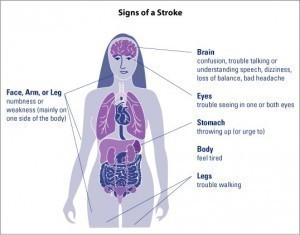Symptoms of Minor Stroke - Don't Ignore it.
Posted by Dr G [GNN] on Wednesday, April 8, 2015 Under: Health & Medical
FYI: This health information appeared in a Medical Symptoms Guide reference, if you experience any health problem please contact your personal physician or call 911 (in U.S) immediately.
Symptoms of a Minor Stroke
Stroke results due to blockage of blood flow from the heart to the brain. This condition can lead to arrest of brain function and other debilitating conditions and in some major cases even death. Once the normal flow and supply of blood to the brain becomes insufficient, brain cells slowly die due to lack of nutrients and oxygen to sustain its functions. There are various forms of stroke. It consists of minor and major symptoms which typically depend on the extent of brain damage sustained. Immediate recognition of the symptoms of minor stroke is the key to prevent major catastrophic consequences of stroke. Signs and Symptoms of Mild Strokes The symptoms of minor strokes usually vary depending which artery of the brain is affected. But there are common symptoms of minor strokes that one should be aware of since most mild strokes often occur unnoticed. These symptoms usually involve numbness and weakness on the face, leg and arm. The weakness usually occurs on one side which is on the opposite side where the brain lesion occurs.
One will also experience speech difficulty and confusion. Other symptoms of minor stroke also involve trouble seeing, dizziness, uncoordinated movements and loss of balance. A sudden headache with unknown cause is also a sign of symptoms of minor stroke. Blurred vision is also an indication of a mild stroke symptom that must be given due attention,diagnosis and treatment.
Diagnosing Symptoms of Mild Stroke The diagnosis of symptoms of minor stroke will substantially depend on the reported symptoms and physical assessment of the physician. The past medical history of the patient is also determined while the basic vital signs are monitored such as the blood pressure, pulse and respiration. Neurological examinations are also carried out to determine the extent of the disability of the patient.
Laboratory tests are important diagnostic tools including blood work such as blood sugar, salt balance, kidney function, white blood cell count, and hematocrit test. X-ray test is sometimes ordered but most of the time CT scan and MRI are more reliable diagnostic tools for stroke. ECG is also ordered to recognize irregular heart beats.
Treatment of Symptoms of Minor Stroke The treatments for symptoms of minor stroke include supportive treatment, self help treatment, medication and lifestyle modification. Supportive treatment consists of management of the symptoms felt such as providing oxygen to alleviate shortness of breath and providing fluids when dehydrated. Medication treatment includes administering antiplatelet drugs such as aspirin, Ticlopidine, Clopidogrel, and Dipyrimadole. Anticoagulant drugs are also prescribed such as Warfarin and Heparin. Thrombolytic therapy is the maintreatment goal for the treatment of symptoms of minor stroke aimed to break up the clot formation in the brain.
It is thus crucial to recognize the early symptoms of mild stroke in order to provide preventive measures against the most catastrophic sequelae of stroke.
In : Health & Medical
Tags: stroke blood vessels brain numbness ecg artery
comments powered by Disqus
